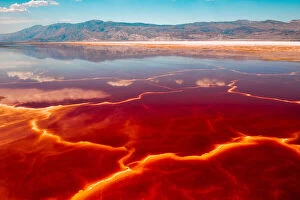Archaea Collection
"Unveiling the Enigmatic World of Archaea: From Red Lake Beds to Ancient Seas" In the picturesque Lone Pine, California, USA
All Professionally Made to Order for Quick Shipping
"Unveiling the Enigmatic World of Archaea: From Red Lake Beds to Ancient Seas" In the picturesque Lone Pine, California, USA, a stunning phenomenon takes place as salt-loving halobacteria turn a shallow lake bed into a vibrant shade of red. Nature's artistry is at play here, showcasing the resilience and adaptability of archaea. Delving deeper into this mysterious realm, we encounter Pyrococcus furiosus archaea artwork that captivates with its intricate details. The delicate strokes depict these heat-loving organisms thriving amidst extreme conditions, reminding us of their remarkable survival strategies. Halobacterium archaea artwork C013 / 5126 mesmerizes with its vivid colors and patterns. It serves as an artistic representation of these ancient microorganisms that have stood the test of time in saline environments across the globe. Transporting our imagination further back in time, we are greeted by an artist's concept depicting Archean stromatolites on the shore of an ancient sea. These captivating structures were formed by diverse microorganisms venturing out from their oceanic homes onto two volcanic landscapes—a testament to life's tenacity and evolution. Zooming into molecular levels, we encounter fascinating glimpses into the inner workings through images like Archaeon enzyme F006 / 9459 and Bacteriorhodopsin protein F006 / 9327. These molecular models showcase intricate mechanisms employed by these organisms for various biological processes—an awe-inspiring display of nature's ingenuity. Bacteriorhodopsin proteins F006 / 9299 and F006 / 9260 continue to unravel secrets held within archaeal cells. Their unique structures hint at specialized functions crucial for energy production or light sensing—highlighting how even at microscopic scales, life has evolved ingenious solutions to thrive in challenging environments. As our journey through this enigmatic world nears its end, we once again encounter the intricate beauty of Archaeon enzyme molecular models.






















